|
Costumes & Characters
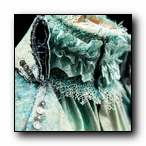 The Alegría costume design evokes a once glorious
kingdom now in decay. In this dusty, stuffy kingdom in dire need of hope and renewal, the
costumes of the old Aristocrats have progressively become tattered, ragged and frayed.
The colours and motifs, once bright and radiant, have faded over time. The fabric of the
artists’ clothes and their bodies have cuts and scratches that mark the passage of time.
These marks and textures were digitally printed on the fabric, and these features also
found their way into the make-up design. For both the costumes and the make-up, the
approach was to highlight the human dimension of the characters by showing the
artists’ shapes, facial features and hair — in a word, their humanity.
The Alegría costume design evokes a once glorious
kingdom now in decay. In this dusty, stuffy kingdom in dire need of hope and renewal, the
costumes of the old Aristocrats have progressively become tattered, ragged and frayed.
The colours and motifs, once bright and radiant, have faded over time. The fabric of the
artists’ clothes and their bodies have cuts and scratches that mark the passage of time.
These marks and textures were digitally printed on the fabric, and these features also
found their way into the make-up design. For both the costumes and the make-up, the
approach was to highlight the human dimension of the characters by showing the
artists’ shapes, facial features and hair — in a word, their humanity.
| |
More than 1,000 meters of fabric was printed using a technique called
sublimation, which fixes the images in the fibers of the material. There
are 96 costumes and 533 different costume elements in the show. As an example,
the mesh used in the costumes of the Bronx is made of the same material used in
making hockey nets. Designers spent nearly 500 hours developing the make-up concepts
and more than a thousand hours teaching the artists how to apply it to their own
faces. Approximately 1,800 items are used in applying make-up: 1,500 brushes, 2 km
of foil paper, 12 gallons of coconut oil and 1.4 kg of glitter.
|
The lead character, Mr. Fleur, is inspired by the fool in the royal court. Thus
the artist’s body movements are exaggerated, as is his elongated black brimmed hat
and overly bushy eyebrows. It took more than 20,000 hours of work to put together the
costumes of the show. Artisans spent 300 hours alone making Mr. Fleur’s costume, which
contains 5 meters of electrical wire.
The lace that covers the crinoline of the White Singer’s skirt is time-worn and
threadbare. This character is an artist bursting with talent who comes from the
street, like a golden-voiced Edith Piaf emerging from the bowels of the city after
overcoming the vicissitudes of a tough life. She continues to sing of hope amidst the
darkness and the gloom. The Singer in Black, more tenacious than her counterpart, is
clad in a modernistic, angular dress to match her resolve.
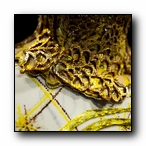 The Aristocrats symbolize all of those who resist change and cling to their old
values. The older members of this decrepit aristocracy sport extravagant hats and
hide behind their jumbled, flamboyant costumes that have seen better days. The powder
on their faces has caked and flaked over time. In this kingdom caught between reason
and unreason, some of the Aristocrat’s faces are ornamented with old jewels, a
testament to their status. One of the Aristocrats wears personalized monocles in
the form of a silicone-based prosthesis while others have overly long noses and
oversized, removable eyes.
The Aristocrats symbolize all of those who resist change and cling to their old
values. The older members of this decrepit aristocracy sport extravagant hats and
hide behind their jumbled, flamboyant costumes that have seen better days. The powder
on their faces has caked and flaked over time. In this kingdom caught between reason
and unreason, some of the Aristocrat’s faces are ornamented with old jewels, a
testament to their status. One of the Aristocrats wears personalized monocles in
the form of a silicone-based prosthesis while others have overly long noses and
oversized, removable eyes.
The Angels are extensions of humans in the afterlife. They are humans with a past,
a history, a lifetime worth of experience. They bear the scars of their life on Earth,
and their costumes are threadbare, with a patina effect created using textile
printing techniques. Their costumes acquire luminous, golden hues as light slowly
brightens up their world.



Mr. Fleur
Following the mysterious disappearance of the king, Mr. Fleur pictures
himself as the legitimate heir to the throne and clumsily tries to impose
his authority. The old king’s fool, Mr. Fleur is a conceited, manipulative
and unpredictable character forever caught in a tug-of-war between reason
and unreason, between an overpowering urge to charm and a desire to control.
The Bronx
The Bronx spring forth from the street. Fiery and full of energy, they
try vigorouslyto defy the established order. Together, they will shake the
pillars of power, lighting the spark that will trigger changes in the very
heart of the kingdom. The Bronx offer a glimmer of hope in a world of gloom.
The Nymphs
The Nymphs personify the purity of youth. Graceful and delicate, they
navigate the space between heaven and earth. They symbolize the dual forces
at play in Mr. Fleur’s mind—reason and unreason, but also empathy and apathy -
which fuel his quest for power.
The Angels
With the distinctive golden star their wear on their solar plexus, the
Angels embody the intangible wind of change, the inner transformations
propelled by the desire for a better world. Imbued with humanity, these
beings from the afterlife carry on their bodies the scars of their earthly
life. With their mere presence, the Angels generate a celestial energy that
lifts the soul.
The Aristocrats
Strange heirs to power in this dusty and timeless world, the Aristocrats
seek to retain their privileges by siding with the Fool; they aim to maintain
the status quo at all costs and so avoid being swept away by the winds of
change. Their once splendid attire has become threadbare. On their faces,
strangely distorted by the passage of time, one can see the fear of progress
and the selfish desire for power.
The Singers
Opposite yet complementary forces, the Singers in Black and in White
are paragons of resilience. The Singer in Black embodies commitment, tenacity
and the indomitable power of hope. The Singer in White is naïve, yet wise in
the face of adversity. Together, they become an unstoppable, inspirational
force in this realm longing for light and hope.
The Clowns
At first Mr. Fleur’s allies, the Clowns also have fun at his expense.
Brothers in humor, this pair of zany Aristocrats is at ease in this crazy
environment and make light of any situation. Wielding the power of imagination
and friendship, they both witness and comment the profound changes at play in
their world. They have two acts in the show: "Dual", which comes in the
first half, and "Cleaning", in the second half.
|
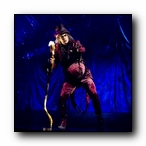
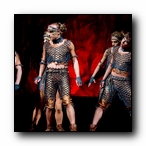
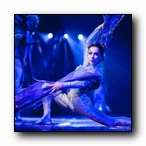
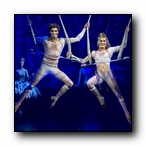
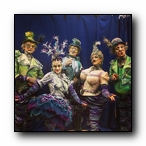
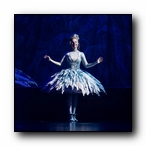
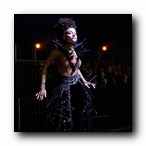
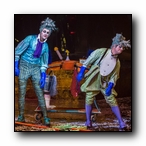
|
|

![]()




